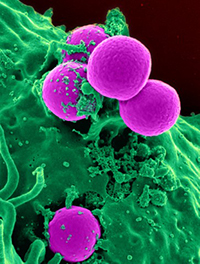Immunity and Your Health
Ever wonder why some people get sick more than others?
Science and medical research prove your immunity system is the key to your ability to fight off germs, viruses, and other bodily invaders that can lead to such ailments as colds, the flu, certain diseases, and many more threats to your health.
The overall function of the immune system is to prevent or limit infection. An example of this principle is found in immune-compromised people, including those with genetic immune disorders, immune-debilitating infections like HIV, and even pregnant women, who are susceptible to a range of microbes that typically do not cause infection in healthy individuals.
The immune system can distinguish between normal, healthy cells and unhealthy cells by recognizing a variety of "danger" cues called danger-associated molecular patterns (DAMPs). Cells may be unhealthy because of infection or because of cellular damage caused by non-infectious agents like sunburn or cancer. Infectious microbes such as viruses and bacteria release another set of signals recognized by the immune system called pathogen-associated molecular patterns (PAMPs).
When the immune system first recognizes these signals, it responds to address the problem. If an immune response cannot be activated when there is sufficient need, problems arise, like an infection. On the other hand, when an immune response is activated without a real threat or is not turned off once the danger passes, different problems arise, such as allergic reactions and autoimmune disease.
The immune system is complex and pervasive. There are numerous cell types that either circulates throughout the body or reside in a particular tissue. Each cell type plays a unique role, with different ways of recognizing problems, communicating with other cells, and performing their functions. By understanding all the details behind this network, researchers may optimize immune responses to confront specific issues, ranging from infections to cancer.
Location
All immune cells come from precursors in the bone marrow and develop into mature cells through a series of changes that can occur in different parts of the body.
Skin: The skin is usually the first line of defense against microbes. Skin cells produce and secrete important antimicrobial proteins, and immune cells can be found in specific layers of skin.
Bone marrow: The bone marrow contains stems cells that can develop into a variety of cell types. The common myeloid progenitor stem cell in the bone marrow is the precursor to innate immune cells—neutrophils, eosinophils, basophils, mast cells, monocytes, dendritic cells, and macrophages—that are important first-line responders to infection.
The common lymphoid progenitor stem cell leads to adaptive immune cells—B cells and T cells—that are responsible for mounting responses to specific microbes based on previous encounters (immunological memory). Natural killer (NK) cells also are derived from the common lymphoid progenitor and share features of both innate and adaptive immune cells, as they provide immediate defenses like innate cells but also may be retained as memory cells like adaptive cells. B, T, and NK cells also are called lymphocytes.
Bloodstream: Immune cells constantly circulate throughout the bloodstream, patrolling for problems. When blood tests are used to monitor white blood cells, another term for immune cells, a snapshot of the immune system is taken. If a cell type is either scarce or overabundant in the bloodstream, this may reflect a problem.
Thymus: T cells mature in the thymus, a small organ located in the upper chest.
Lymphatic system: The lymphatic system is a network of vessels and tissues composed of lymph, an extracellular fluid, and lymphoid organs, such as lymph nodes. The lymphatic system is a conduit for travel and communication between tissues and the bloodstream. Immune cells are carried through the lymphatic system and converge in lymph nodes, which are found throughout the body.
Lymph nodes are a communication hub where immune cells sample information brought in from the body. For instance, if adaptive immune cells in the lymph node recognize pieces of a microbe brought in from a distant area, they will activate, replicate, and leave the lymph node to circulate and address the pathogen. Thus, doctors may check patients for swollen lymph nodes, which may indicate an active immune response.
Spleen: The spleen is an organ located behind the stomach. While it is not directly connected to the lymphatic system, it is important for processing information from the bloodstream. Immune cells are enriched in specific areas of the spleen, and upon recognizing blood-borne pathogens, they will activate and respond accordingly.
Mucosal tissue: Mucosal surfaces are prime entry points for pathogens, and specialized immune hubs are strategically located in mucosal tissues like the respiratory tract and gut. For instance, Peyer's patches are important areas in the small intestine where immune cells can access samples from the gastrointestinal tract.





No comments:
Post a Comment